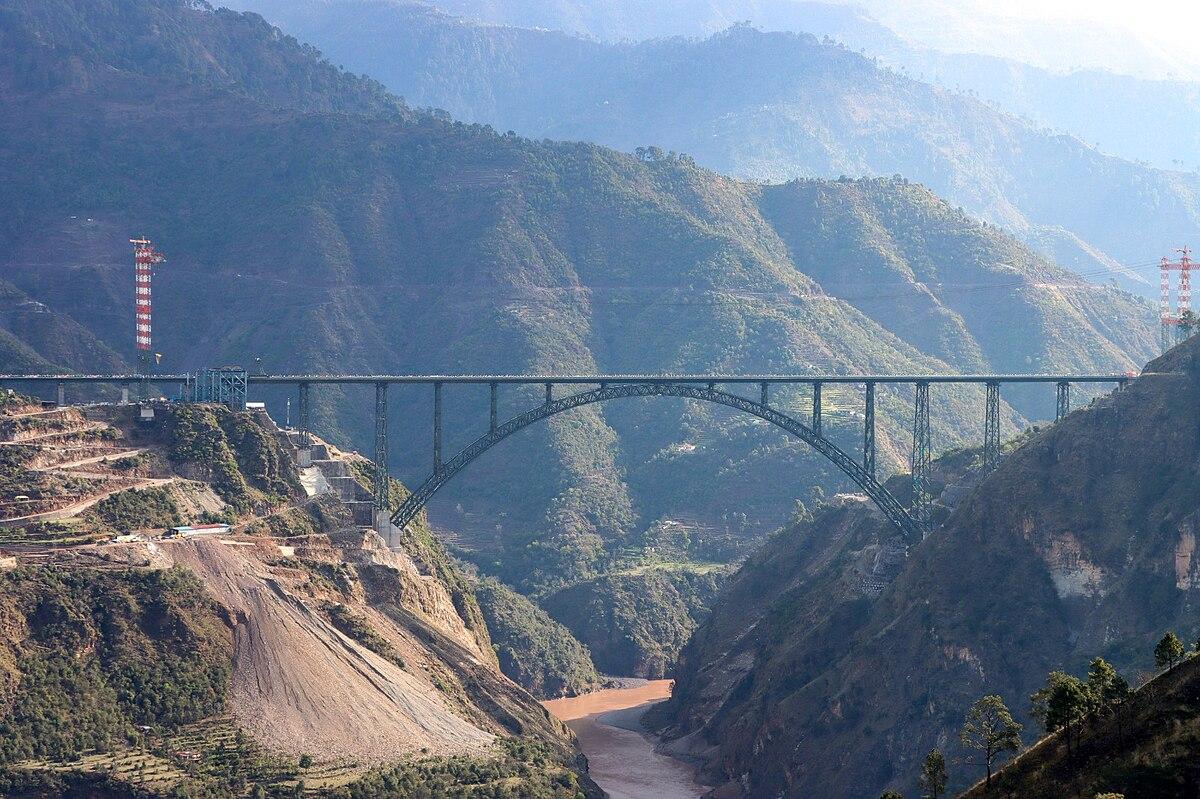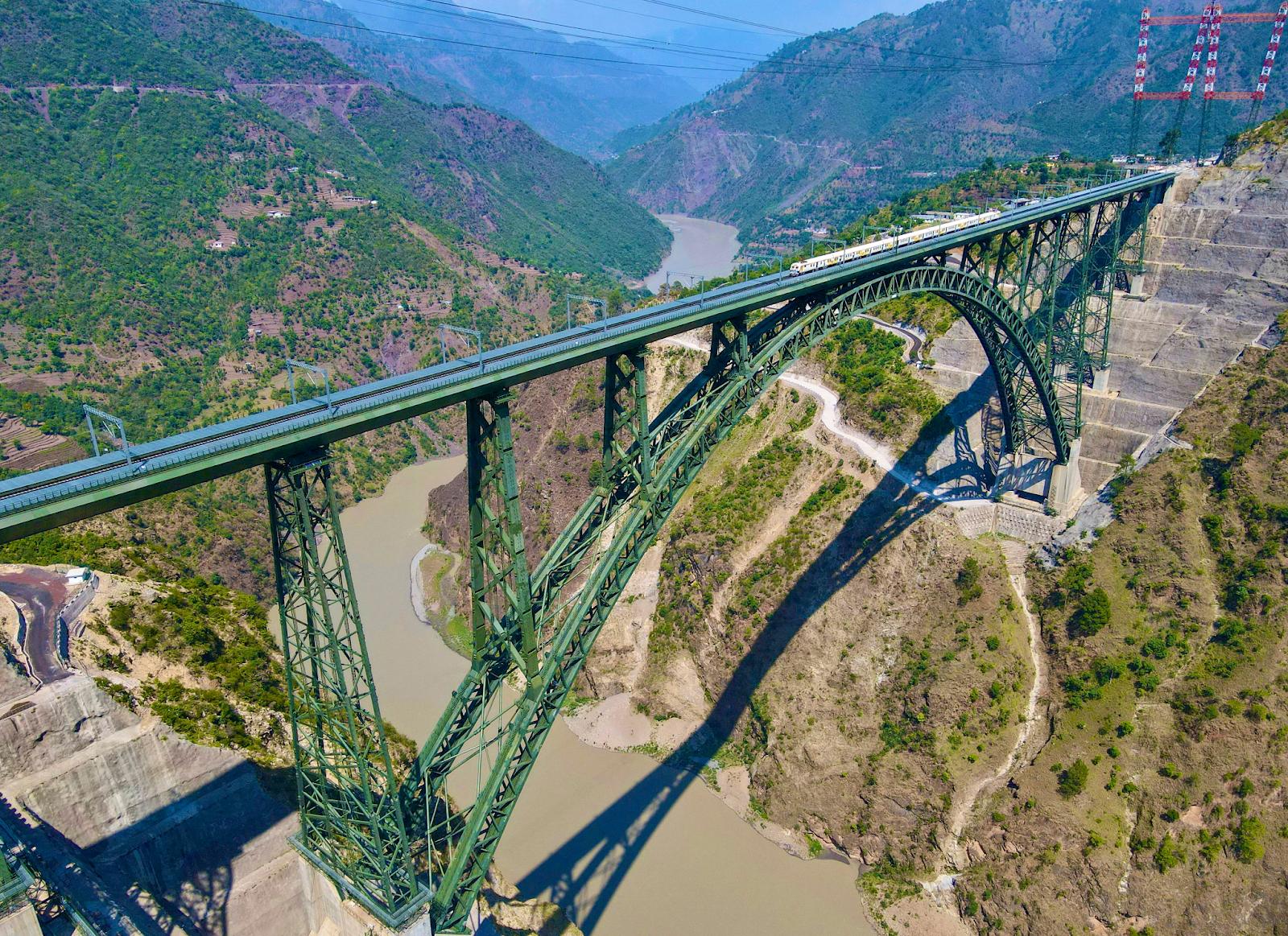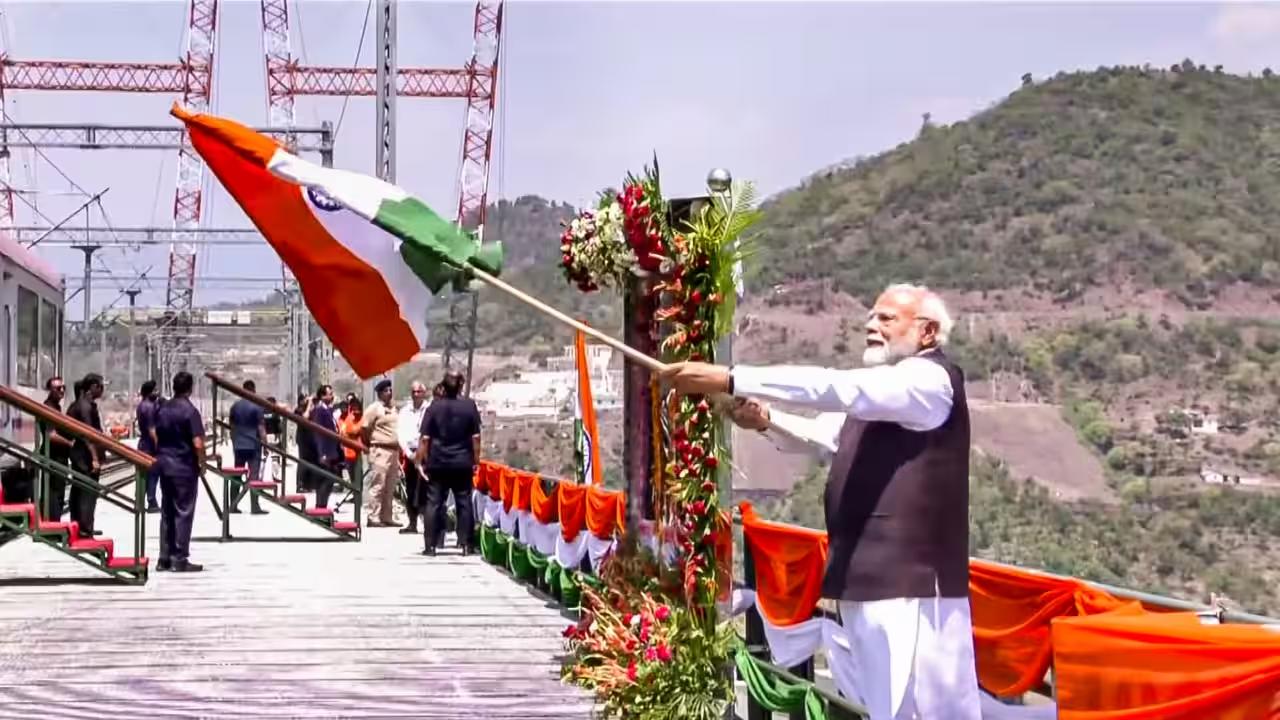



Table of Contents
- Introduction
- Historical Background and Strategic Purpose
- Project Timeline and Key Milestones
- Engineering and Design Highlights
- Construction Challenges and Innovations
- Safety, Durability, and Environmental Adaptation
- National Significance and Economic Impact
- Inauguration and Rail Services Launch
- Complementary Projects: USBRL and Anji Khad Bridge
- Boost to Tourism and Local Economy
- Future Outlook
- Conclusion
- Faq's
Introduction
The Chenab Rail Bridge is a symbol of engineering brilliance and national integration. Situated in the Reasi district of Jammu and Kashmir, it now holds the record as the world's highest railway bridge. Towering 359 metres above the riverbed, this iconic structure stands taller than the Eiffel Tower and forms a crucial part of the Udhampur-Srinagar-Baramulla Railway Link (USBRL). Its completion marks a turning point in connecting Kashmir to the rest of India by rail for the first time in history.

Chenab Rail Bridge, Wiki
After decades of planning, technical challenges, and strategic prioritisation, the bridge was inaugurated for operational use on 6 June 2025. This milestone showcases not just India's engineering prowess but also its commitment to equitable regional development and stronger national integration.
Historical Background and Strategic Purpose
The idea of connecting Kashmir to the Indian railway network dates back to the 19th century. However, due to difficult terrain, technical limitations, and political instability, the vision remained unrealised for over a century. It was only in the early 2000s that the Indian Railways committed to the USBRL project with renewed momentum.
The Chenab Bridge, being the most challenging segment of this railway link, was critical to ensuring all-weather, uninterrupted access to Kashmir. The structure had to be durable, resilient, and strategically sound to support both civilian and defence logistics.
Also Read: Nagpur Metro Phase 2 Overview: Stations, Timelines, and the Kanhan Extension
Project Timeline and Key Milestones
The Chenab Rail Bridge journey spanned over two decades from conceptualisation to commissioning. Below is a quick timeline of major milestones:

Chenab Rail Bridge, Mint
|
Year |
Milestone Description |
|
2003 |
USBRL project approved by Indian Railways |
|
2008 |
Initial groundwork began, followed by halts due to design challenges |
|
2010 |
Redesigned plans cleared and construction resumed |
|
2017 |
Foundation and arch construction accelerated |
|
2021 |
Arch closure successfully achieved |
|
2022 |
Superstructure and deck completed |
|
2023 |
Trial track laying and inspections initiated |
|
June 2025 |
Official inauguration and commencement of rail services |
Engineering and Design Highlights
The Chenab Rail Bridge is a steel and concrete arch bridge with state-of-the-art design features. Its total length is 1315 metres, and the main arch span measures 467 metres. The bridge was built using deck-arch construction, combining aesthetics with functionality.
Key design attributes include:
- Height: 359 metres above riverbed, making it the tallest railway bridge globally.
- Arch Span: 467 metres long, connecting two mountains across a deep gorge.
- Material Used: Around 30,000 tonnes of steel, including corrosion-resistant alloys.
- Longevity: Designed to last over 120 years with minimum maintenance.
- Wind and Seismic Resistance: Capable of withstanding wind speeds of 260 kmph and seismic activity up to magnitude 8.
Also Read: Thane-Borivali Tunnel Project: Route, Timeline, Cost, and Latest Developments
Construction Challenges and Innovations
Building the Chenab Rail Bridge involved overcoming unprecedented challenges. The terrain was remote, mountainous, and geologically unstable. The site lacked proper access roads, and construction could only proceed using rope cranes and helicopters for material movement.
Innovations that helped accomplish the build include:
- Use of cable-stayed cantilever methods to erect the arch from both ends
- Customised blast-resistant design to withstand threats
- On-site power generation and fabrication yards
- Advanced corrosion-proof paint technology with 15-year protection
- Real-time structural health monitoring systems
Despite snow, rain, and wind disruptions, the project maintained strict safety and quality standards throughout.
Safety, Durability, and Environmental Adaptation
The Chenab Rail Bridge is built to endure some of the most extreme natural forces in the region. Key safety and durability features include:
- Seismic Stability: Equipped with shock absorbers and dampers to handle earthquakes
- Wind Shielding: Structural elements withstand winds up to 260 kmph
- Temperature Resistance: Designed to function in temperatures ranging from -10°C to +40°C
- Blast Proofing: Capable of resisting high-intensity explosions
- Corrosion Protection: Special coatings and steel blends prevent deterioration
These features ensure the bridge's usability for decades under high-stress environmental and security conditions.
Also Read: Universal Studios' Theme Park Coming Soon to India
National Significance and Economic Impact
The completion of the Chenab Bridge is a strategic game-changer for India. It not only brings Kashmir closer to the Indian heartland but also boosts regional development and national defence logistics.
- Travel Time Reduction: Katra to Srinagar train travel now takes just 3 hours compared to over 6 hours by road.
- Military Access: Enables faster troop and equipment movement to border areas.
- Boost to Tourism: Easier access for pilgrims visiting Vaishno Devi and tourists heading to Kashmir.
- Trade and Employment: Local industries like fruit farming, handicrafts, and tourism will benefit from seamless logistics and increased footfall.
- Symbolic Unity: The bridge represents India's dedication to integrating Kashmir socioeconomically.
Inauguration and Rail Services Launch
On 6 June 2025, the Chenab Rail Bridge was inaugurated by Prime Minister Narendra Modi in a nationally televised event. The ceremony also marked the operational launch of the Katra-Srinagar Vande Bharat Express, which is now equipped with winterised features such as heated windshields and insulation.

Chenab Rail Bridge Inauguration by PM Narendra Modi, Moneycontrol
The bridge, along with the Anji Khad Cable-Stayed Bridge, forms the crown jewel of the USBRL. The event was attended by senior officials from Indian Railways, Konkan Railway Corporation, and the Ministry of Defence.
Complementary Projects: USBRL and Anji Khad Bridge
The Chenab Bridge is one part of the larger USBRL project, a 272 km electrified railway corridor. The route includes:
- 38 tunnels, including the 11.2 km Pir Panjal Tunnel (India's longest)
- 900+ bridges, viaducts, and flyovers
- The Anji Khad Bridge, India's first cable-stayed railway bridge
- Multiple stations modernised with amenities for passengers and goods transit
Together, these infrastructure elements will revolutionise rail travel and logistics in the Jammu and Kashmir region.
Boost to Tourism and Local Economy
With the launch of rail services through the Chenab Bridge, the local economy is expected to benefit in multiple ways:
- Tourist Influx: Shorter and safer travel routes encourage both domestic and international tourists
- Hospitality Growth: Increased demand for hotels, restaurants, and local tours in Kashmir
- Agricultural Trade: Faster transportation of fresh produce to major Indian markets
- Handicraft Exports: Kashmiri artisans gain better access to nationwide buyers and e-commerce channels
- Employment: Infrastructure, logistics, and service sector jobs will see a sharp increase
Future Outlook
The Chenab Rail Bridge is just the beginning. Going forward, the region will see:
- Expansion of high-speed rail services to other parts of Jammu and Kashmir
- Development of dedicated freight corridors for agricultural and textile goods
- Eco-tourism infrastructure along the rail route
- Increased public-private partnerships in hospitality and mobility
- Improved security surveillance systems across the USBRL network
Conclusion
The Chenab Rail Bridge is more than just a structural wonder, it is a statement of India's engineering capabilities, political will, and developmental aspirations. Connecting Kashmir to the national railway network through such a feat of engineering sends a powerful message of inclusion and unity. It not only uplifts the region economically but also strengthens national integration and security. As the bridge becomes operational, it heralds a new era of progress for Jammu and Kashmir.
explore further
Latest from Editorials
More from Publications
Resources
Dwello, for every home buyer, is a way to go from 'I feel' to 'I know', at no extra cost.



